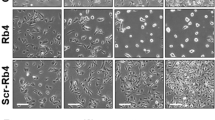Abstract
The anticancer properties and mechanism of action of a hybrid peptide -P18 were investigated. It had significant cytotoxic activity against human melanoma cells and low toxicity to normal NIH-3T3 cells. It also induced cell death via necrosis rather than classical apoptosis. The peptide targets the cells membrane, causing a sustained depolarization of transmembrane potential resulting in the cells swelling and bursting, thereby triggering cytolysis. P18 peptide initially binds to the melanoma cell membrane via electrostatic interaction, causing the cell membrane to rupture. The effect may be mediated by the amphiphilic α-helical structure of P18 peptide, coupled with changes in ion channels and an increase in plasma membrane permeability that eventually leads to melanoma cell death.




Similar content being viewed by others
References
Bae J, Jang K, Yim H et al (2005) Polysaccharides isolated from Phellinus gilvus inhibit melanoma growth in mice. Cancer Lett 218:43–52
Barros LF, Castro J, Bittner CX (2002) Ion movements in cell death: from protection to execution. Biol Res 35(2):209–214
Cruciani RA, Barker JL, Zasloff M et al (1999) Antibiotic magainins exert cytolytic activity against transformed cell lines through channel formation. Proc Natl Acad Sci USA 88:3792–3796
Dekker N, Cox RC, Kramer RA et al (2001) Substrate specificity of the integral membrane protease OmpT determined by spatially addressed peptide libraries. Biochemistry 40(6):1694–1701
Dobrzynska J, Szachowicz-Petelska B, Sulkowski S et al (2005) Changes in electric charge and phospholipids composition in human colorectal cancer cells. Mol Cell Biochem 276:113–119
Gawlitta D, Oomens CWJ, Baaijens FPT et al (2004) Evaluation of a continuous quantification method of apoptosis and necrosis in tissue cultures. Cytotechnology 46:139–150
Giuliani A, Pirri G, Nicoletto SF (2007) Antimicrobial peptides: an overview of a promising class of therapeutics. Central Eur J Biol 2:1–33
Hancock RE, Chapple DS (1999) Peptide antibiotics. Antimicrob Agents Chemother 43:1317–1323
Kalkman E, Baxter G (2004) Melanoma. Clin Radiol 59:313–326
Malafa MP, Fokum FD, Mowlavi A et al (2002) Vitamin E inhibits melanoma growth in mice. Surgery 131:85–91
Oh D, Shin SY, Kang JH et al (1999) NMR structural characterization of cecropin A (1–8)–magainin 2 (1–12) and cecropin A (1–8)–melittin (1–12) hybrid peptides. J Pept Res 53:578–589
Shin SY, Lee SH, Yang ST et al (2001) Antibacterial, antitumor and hemolytic activities of α-helical antibiotic peptide, P18 and its analogs. J Pept Res 58:504–514
Tsukimoto M, Harada H, Ikari A et al (2005) Involvement of chloride in apoptotic cell death induced by activation of ATP-sensitive P2X7 purinoceptor. J Biol Chem 280(4):2653–2658
Yoon WH, Park HD, Lim K et al (1996) Effect of O-glycosylated mucin on invasion and metastasis of HM7 human colon cancer cells. Biochem Biophys Res Commun 222:694–699
Zachowski A (1993) Phospholipids in animal eukaryotic membranes: transverse asymmetry and movement. Biochem J 294:1–14
Acknowledgments
This research was supported in part by National 985 Key Project of Sichuan University of the Education Ministry of China. Authors would like to thank Guizhi Du for his helpful discuss and critical reading during the manuscript preparation.
Author information
Authors and Affiliations
Corresponding author
Rights and permissions
About this article
Cite this article
Huang, W., Lu, L., Shao, X. et al. Anti-melanoma activity of hybrid peptide P18 and its mechanism of action. Biotechnol Lett 32, 463–469 (2010). https://doi.org/10.1007/s10529-009-0175-2
Received:
Revised:
Accepted:
Published:
Issue Date:
DOI: https://doi.org/10.1007/s10529-009-0175-2




